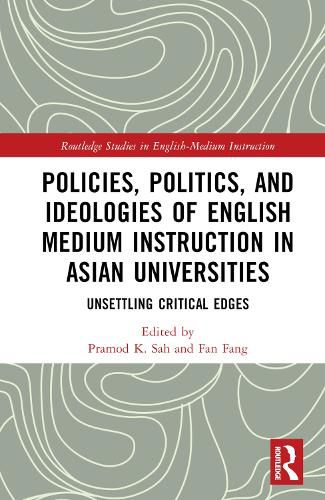Readings Newsletter
Become a Readings Member to make your shopping experience even easier.
Sign in or sign up for free!
You’re not far away from qualifying for FREE standard shipping within Australia
You’ve qualified for FREE standard shipping within Australia
The cart is loading…






Against the backdrop of uncritical promotions of English-medium instruction (EMI) in higher education globally, this edited volume maps out the political, ideological, and policy-related issues of EMI programs in multilingual and multicultural universities in Asia.
In this volume, EMI researchers and practitioners involved in different Asian countries and regions have collaboratively unpacked the critical dimensions of EMI programs in higher education, with a goal to provide must-needed resources for researchers, graduate students, higher education leaders, and policymakers. This volume is the first of its kind in that it provides an exclusive and critical tapestry of EMI at multilingual universities from all parts of Asia, including Central Asia (Kazakhstan), East Asia (Mainland China, Korea, Japan, and Taiwan), South Asia (Bangladesh and Nepal), Southeast Asia (Brunei, Malaysia, Philippines, Thailand, and Vietnam), and Western Asia (United Arab Emirates). The key takeaway for the reader is to not only understand the current phenomenon of EMI in Asian universities but to also learn the dark side of its policies, programs, and practices that have led to unequal teaching and learning spaces in diverse societies.
This collection will be of interest to scholars and policymakers in English-medium instruction, English language teaching, TESOL, and applied linguistics.
$9.00 standard shipping within Australia
FREE standard shipping within Australia for orders over $100.00
Express & International shipping calculated at checkout
Against the backdrop of uncritical promotions of English-medium instruction (EMI) in higher education globally, this edited volume maps out the political, ideological, and policy-related issues of EMI programs in multilingual and multicultural universities in Asia.
In this volume, EMI researchers and practitioners involved in different Asian countries and regions have collaboratively unpacked the critical dimensions of EMI programs in higher education, with a goal to provide must-needed resources for researchers, graduate students, higher education leaders, and policymakers. This volume is the first of its kind in that it provides an exclusive and critical tapestry of EMI at multilingual universities from all parts of Asia, including Central Asia (Kazakhstan), East Asia (Mainland China, Korea, Japan, and Taiwan), South Asia (Bangladesh and Nepal), Southeast Asia (Brunei, Malaysia, Philippines, Thailand, and Vietnam), and Western Asia (United Arab Emirates). The key takeaway for the reader is to not only understand the current phenomenon of EMI in Asian universities but to also learn the dark side of its policies, programs, and practices that have led to unequal teaching and learning spaces in diverse societies.
This collection will be of interest to scholars and policymakers in English-medium instruction, English language teaching, TESOL, and applied linguistics.